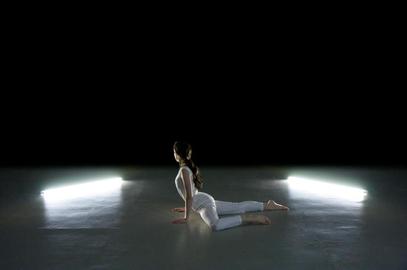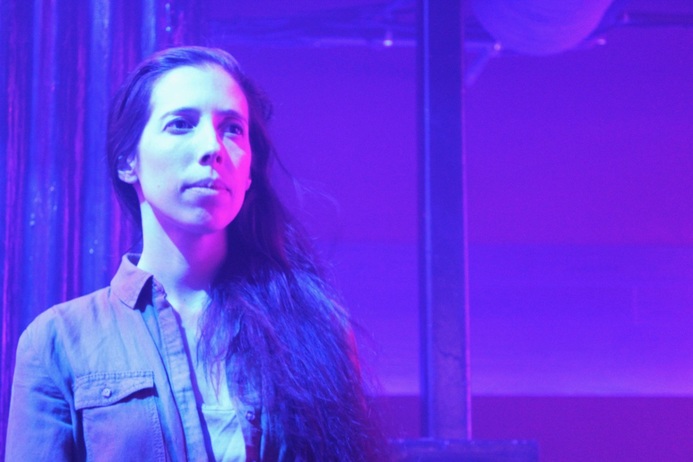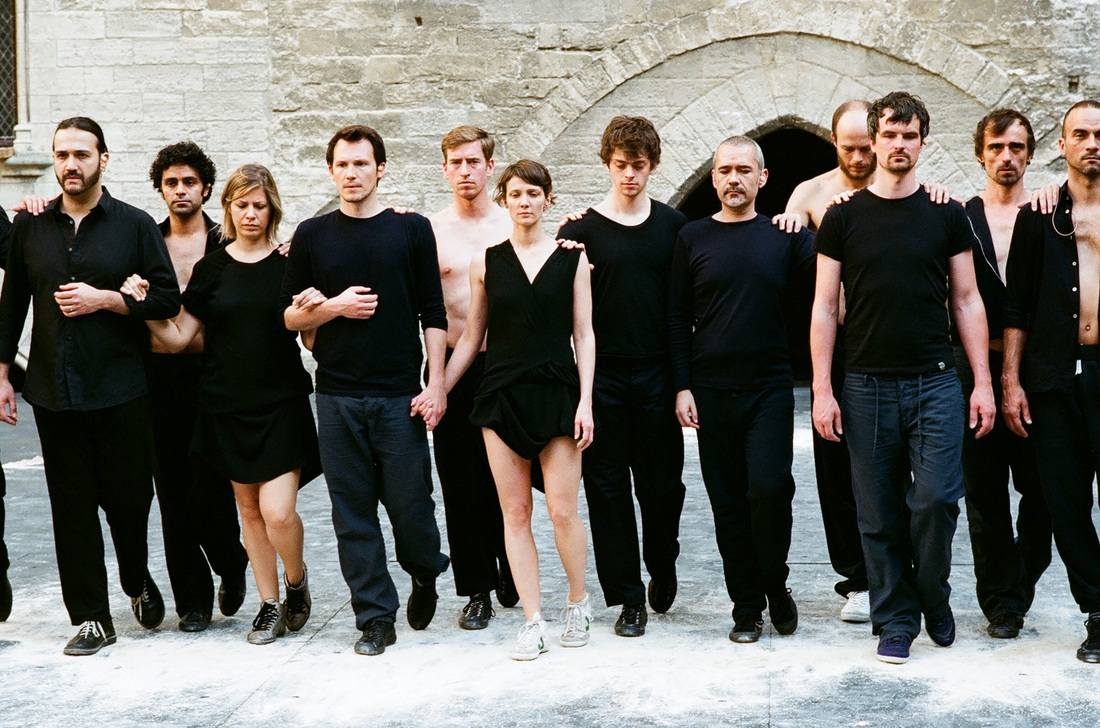|
A minimalist at heart, Dorian Nuskind-Oder’s compositions emerge from a process that emphasizes economy of means and physical precision. Conceptual, but not cold, her work searches for poetic complexity through the cultivation of simple but ambiguous images. After completing her training at New York University and the Merce Cunningham Studio, Dorian worked as a freelance dancer and video editor in New York from 2004 until 2009, when she relocated to Montreal. Upon her arrival in Quebec, Dorian began collaborating with visual artist Simon Grenier-Poirier under the company name Delicate Beast. Supported by organizations like the Conseil des Arts de Montréal, Circuit-Est Centre Chorégraphique, Studio 303, and Tangente, the company has created four works, which have been presented in Montreal, Quebec City, Halifax, Boston, and Nottingham (UK).
Why do you move? It's pretty simple, actually: I move because it feels good and connects me to my body and the bodies of those around me. Also, it's virtually impossible for me to be dancing and thinking about my e-mail at the same time. What are you most proud of? In general, I have a lot of admiration for my own and other artists’ capacity to continue to create in the face of frequent rejection. I recently told someone that this sense of resilience is our superpower, and I totally believe that. What or who was your first dance love? I remember seeing John Jasperse's work for the first time at the American Dance Festival in 1999. I was sixteen. Up to that point, my training had been in classical ballet, and I had always felt like a bit of an outsider. Seeing John's work – which is really meticulous and prickly and sensual and cerebral – that was the first time I looked at a choreography and felt genuinely engaged. What does dance most need today? More time, less product. How do you feel about dance criticism? It is a process I am a part of, not something that is being done to me. Given the means, which dance fantasy would you fulfill? I'd build an Art Farm, a retreat in the woods where artists can come and work for intensive periods of time, while also hanging out with horses and dogs, and taking walks through wide open fields. I like living in the city, but I create more productively in places where I can see the horizon. I also like the idea of having a space that I could share with many other people. What motivates you to keep making art? The social nature of performance-making and performance-watching are super important to me. Both require a level of vulnerability and risk-taking that I otherwise would not experience in my day-to-day life. Looking at and making art requires a practice of remaining open and curious in the face of strangeness or not understanding. This practice feels important both to my own life and to society as a whole. Memory Palace February 25-28 www.tangente.qc.ca 514.871.2224 Tickets: 23$ / Students: 19$
0 Comments
 Pale Water (Première Partie), photo by Simon Grenier-Poirier Pale Water (Première Partie), photo by Simon Grenier-Poirier Three choreographers, three pieces, three Canadian cities. Pale Water (Première Partie), Dorian Nuskind-Oder (Montréal) At first, but a backlit silhouette against a white screen. Then, neon strips are positioned on six sides around Nuskind-Oder, with gaps in between, so that the eye can read a hexagon, an octagon, a dodecagon, or a simple triangle depending on the lines that are lit or extrapolated. Many dance shows have live musicians onstage. Pale Water does something cheekier: it is as lighting designer that Simon Grenier-Poirier is onstage. Nuskind-Oder’s movement is quiet, slow, deliberate. Her body is controlled until it appears to be in suspension. I don’t want it to be over. Falling Off the Page, Jacinthe Armstrong (Halifax) Falling Off the Page begins with one dancer’s hand seemingly controlling the other dancer’s foot, like a puppeteer and her dummy. This is the first in a long series of clichés: -They wash their hair in pots filled with water in a purifying ritual. -They travel along a road made of light (after first appearing in a square prison of light). -They unroll a paper carpet along the lit road. -They dip their hair in paint and drag it across the paper. -They look back at the road travelled. One redemptive quality: it is not uncommon for dancers here to jump in the air and let themselves fall heavily back on the ground; in Armstrong’s choreography, the dancers instead jump into the air and let their limbs float up so that for a second they almost seem to fly. La petite mort, Maryse Damecour (Québec) Original movement emerges when a physical constraint is added to an otherwise common gesture, like when Brice Noeser walks on all fours, but with his hands covering his face so that it is his elbows that are dragging him across the floor. It is always refreshing when a choreographer is preoccupied by something other than beauty, when the dance is allowed to be delightfully awkward, and not without humour. La petite mort revels in abrupt transitions and, when it pretends to be joyful, it’s laughable because it rings false. It is always a treat to watch Noeser, who has such a distinct corporality, move. www.tangente.qc.ca www.delicatebeast.com http://damequidanse.com/ My wish for the Montreal dance scene in 2013 is for Marie-Hélène Falcon to quit her job as artistic director of the Festival TransAmériques. I’m hoping she’ll become the director of a theatre so that the most memorable shows will be spread more evenly throughout the year instead of being all bunched up together in a few weeks at the end of spring. With that being said, here are the ten works that still resonated with me as 2012 came to an end. 1. Cesena, Anne Teresa De Keersmaeker + Björn Schmelzer (Festival TransAmériques)
I’ve been thinking about utopias a lot this year. I’ve come to the conclusion that – since one man’s utopia is another’s dystopia – they can only be small in nature: one person or, if one is lucky, maybe two. With Cesena, Belgian choreographer Anne Teresa De Keersmaeker showed me that it could be done with as many as nineteen people, if only for two hours, if only in a space as big as a stage. Dancers and singers all danced and sang, independently of their presupposed roles, and sacrificed the ego’s strive for perfection for something better: the beauty of being in all its humanly imperfect manifestations. They supported each other (even more spiritually than physically) when they needed to and allowed each other the space to be individuals when a soul needed to speak itself. 2. Sideways Rain, Guilherme Botelho (Festival TransAmériques) I often speak of full commitment to one’s artistic ambitions as extrapolated from a clear and precise concept carried out to its own end. Nowhere was this more visible this year than in Botelho’s Sideways Rain, a show for which fourteen dancers (most) always moved from stage left to stage right in a never-ending loop of forward motion. More than a mere exercise, the choreography veered into the metaphorical, highlighting both the perpetual motion and ephemeral nature of human life, without forgetting the trace it inevitably leaves behind, even in that which is most inanimate. More importantly, it left an unusual trace in the body of the audience too, making it hard to even walk after the show. 3. (M)IMOSA: Twenty Looks or Paris Is Burning at the Judson Church (M), Cecilia Bengolea + François Chaignaud + Trajal Harrell + Marlene Monteiro Freitas (Festival TransAmériques) By mixing post-modern dance with queer performance, the four choreographer-dancers of (M)IMOSA offered a show that refreshingly flipped the bird to the usual conventions of the theatre. Instead of demanding silence and attention, they left all the house lights on and would even walk in the aisles during the show, looking for their accessories between or underneath audience members. Swaying between all-eyes-on-me performance and dancing without even really trying, as if they were alone in their bedroom, they showed that sometimes the best way to dramatize the space is by rejecting the sanctity of theatre altogether. 4. Goodbye, Mélanie Demers (Festival TransAmériques) Every time I think about Demers’s Goodbye (and it’s quite often), it’s always in conjunction with David Lynch’s Inland Empire. The two have a different feel, for sure, but they also do something quite similar. In Inland Empire, at times, an actor will perform an emotional scene, and Lynch will then reveal a camera filming them, as if to say, “It’s just a movie.” Similarly, in Goodbye, dancer Jacques Poulin-Denis can very well say, “This is not the show,” it still doesn’t prevent the audience from experiencing affect. Both works show the triviality of the concept of suspension of disbelief, that art does not affect us in spite of its artificiality, but because of it. 5. The Parcel Project, Jody Hegel + Jana Jevtovic (Usine C) One of the most satisfying days of dance I’ve had all year came as a bit of a surprise. Five young choreographers presented the result of their work after but a few weeks of residencies at Usine C. I caught three of the four works, all more invigorating than some of the excessively polished shows that some choreographers spend years on. It showed how much Montreal needs a venue for choreographers to experiment rather than just offer them a window once their work has been anesthetically packaged. The most memorable for me remains Hegel & Jevtovic’s The Parcel Project, which began with a surprisingly dynamic and humorous 20-minute lecture. The second half was an improvised dance performance, set to an arbitrarily selected pop record, which ended when the album was over, 34 minutes later. It was as if John Cage had decided to do dance instead of music. Despite its explanatory opening lecture, The Parcel Project was as hermetic as it was fascinating. 6. Spin, Rebecca Halls (Tangente) Halls took her hoop dancing to such a degree that she exceeded the obsession of the whirling dervish that was included in the same program as her, and carried it out to its inevitable end: exhaustion. 7. Untitled Conscious Project, Andrew Tay (Usine C) Also part of the residencies at Usine C, Tay produced some of his most mature work to date, without ever sacrificing his playfulness. 8. 1001/train/flower/night, Sarah Chase (Agora de la danse) Always, forever, Sarah Chase, the most charming choreographer in Canada, finding the most unlikely links between performers. She manages to make her “I have to take three boats to get to the island where I live in BC” and her “my dance studio is the beach in front of my house” spirit emerge even in the middle of the city. 9. Dark Sea, Dorian Nuskind-Oder + Simon Grenier-Poirier (Wants & Needs Danse/Studio 303) Choreographer Nuskind-Oder and her partner-in-crime Grenier-Poirier always manage to create everyday magic with simple means, orchestrating works that are as lovely as they are visually arresting. 10. Hora, Ohad Naharin (Danse Danse) A modern décor. The legs of classical ballet and the upper body of post-modern dance, synthesized by the athletic bodies of the performers of Batsheva. These clear constraints were able to give a coherent shape to Hora, one of Naharin’s most abstract works to date. Scrooge Moment of the Year Kiss & Cry, Michèle Anne De Mey + Jaco Van Dormael (Usine C) Speaking of excessively polished shows… La Presse, CIBL, Nightlife, Le Devoir, and everyone else seemingly loved Kiss & Cry. Everyone except me. To me, it felt like a block of butter dipped in sugar, deep fried, and served with an excessive dose of table syrup; not so much sweet as nauseating. It proved that there’s no point in having great means if you have nothing great to say. Cinema quickly ruined itself as an art form; now it apparently set out to ruin dance too. And I’m telling you this so that, if Kiss & Cry left you feeling dead on the inside, you’ll know you’re not alone. |
Sylvain Verstricht
has an MA in Film Studies and works in contemporary dance. His fiction has appeared in Headlight Anthology, Cactus Heart, and Birkensnake. s.verstricht [at] gmail [dot] com Categories
All
|


 RSS Feed
RSS Feed